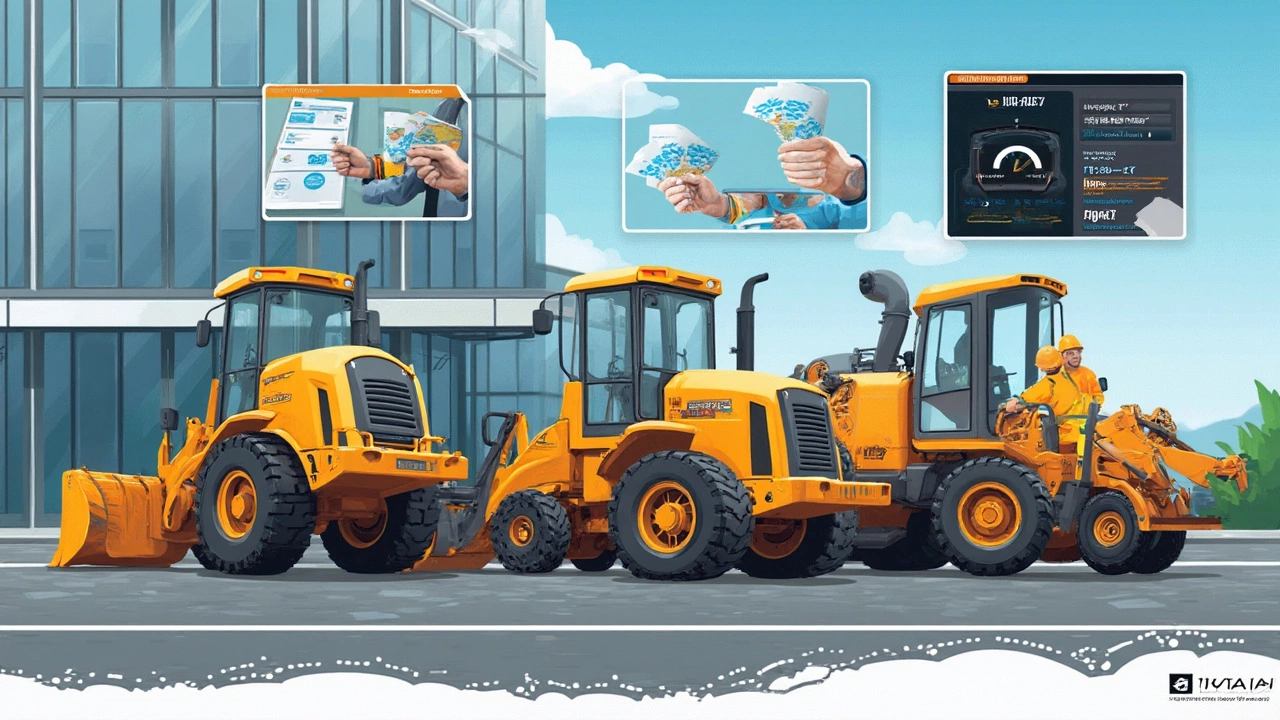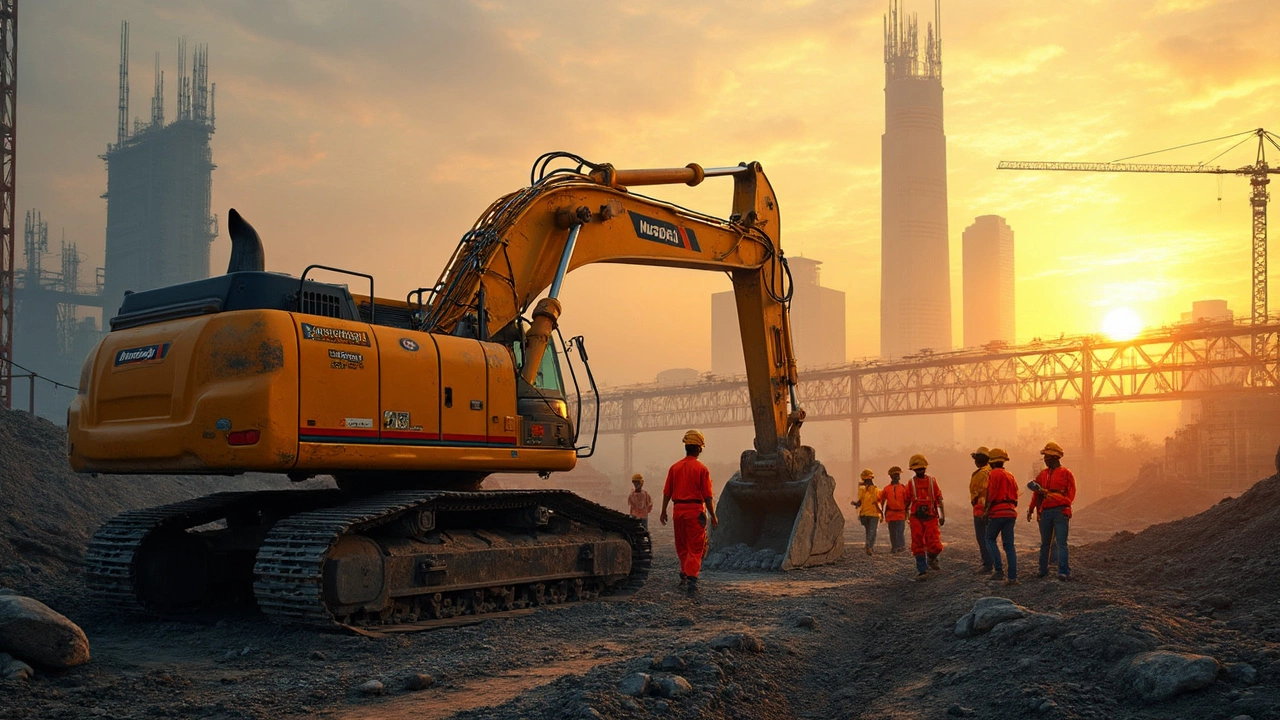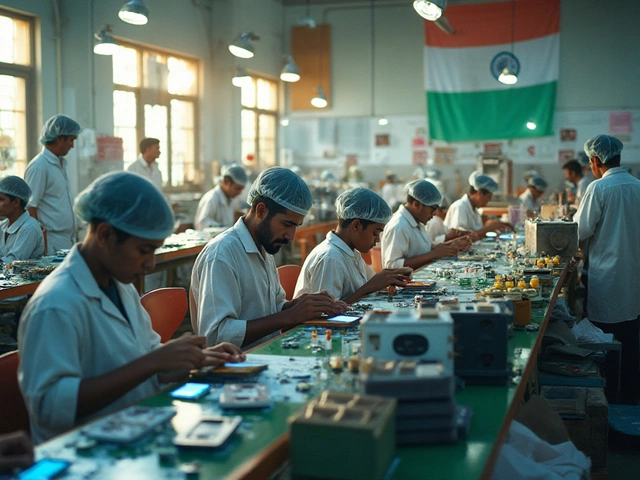The title of Asia’s largest earth moving equipment manufacturer goes to JCB India, hands down. You see their bright yellow machines everywhere—from building highways in Rajasthan to moving piles of debris in Asian megacities. What’s wild is that India isn’t just a big market; it’s now the factory for these machines heading all over the world.
Numbers back this up in a big way. JCB India rolls out over 50,000 earth movers a year from its factories, with plants in places like Ballabgarh and Pune running almost non-stop. Their diggers, backhoe loaders, and excavators don’t just land in local job sites. They’re crated up and shipped to 110 countries.
If you’re in construction or logistics, knowing about JCB India can save you money and headaches. Their machines are built with India's rough terrain in mind, which means they hold up in just about any tough spot. Parts are easy to find, and there’s a service center pretty much everywhere.
- The Big Player: Name and Credentials
- Inside the Machines: What Sets Them Apart
- Global Impact Beyond India
- Tips for Buying Earth Moving Equipment
- Future Trends in Earth Moving Machinery
The Big Player: Name and Credentials
When you talk about the top dog in earth moving equipment across Asia, JCB India is always the first name that pops up. The company is technically a subsidiary of the British giant J.C. Bamford Excavators Ltd, but JCB India has gone way beyond being just a 'branch office.' Since 1979, it’s grown into the biggest manufacturing hub for JCB outside the UK.
Here’s what sets JCB India apart in the machinery India scene:
- Massive Manufacturing Capacity: JCB India churns out over 50,000 machines every year across its five plants in India—including Ballabgarh (the world’s largest backhoe loader factory), Pune, Jaipur, and Vadodara.
- Strong Dealer Network: With more than 60 dealers and 700 outlets, service and parts are never far from any construction site in the country.
- Workforce: It employs around 5,000 people directly and supports thousands more indirectly through suppliers and logistics.
If you’re looking at their product lineup, you’re spoiled for choice. Everything from the standard backhoe loader and excavators, to compact skid steer loaders and telehandlers—all India-made, but with international quality checks.
Check out some quick facts and numbers:
| Year Founded | Number of Plants | Annual Production (Units) | Countries Exported To |
|---|---|---|---|
| 1979 | 5 | 50,000+ | 110+ |
What’s cool is that JCB didn’t just flood India with machines, it made India a global exporting hub. That’s how you end up seeing those familiar yellow backhoes on job sites from Africa all the way to Southeast Asia.
If you’re comparing options in earth moving equipment in Asia, nobody comes close to JCB India for sheer scale, reliability, and after-sales reach.
Inside the Machines: What Sets Them Apart
When you look at earth moving equipment from JCB India, there’s some real muscle and clever engineering under the hood. They build these machines for the world’s toughest jobs, but they keep them simple enough that you don’t need an advanced degree to operate or fix them. That’s why these yellow beasts rule so many job sites across India and Asia.
One standout is the famous JCB backhoe loader. It’s basically the Swiss Army knife of construction—one end digs, the other lifts, and the whole thing runs for years with just basic care. These machines come with easy-to-maintain diesel engines, high ground clearance, and strong hydraulics. In 2024, JCB India introduced engines with air filtration tech that work even in super dusty places, making breakdowns way less common.
What really helps them pull ahead of the pack:
- Fuel Efficiency: JCB machines are known to use up to 15% less fuel than some other brands. That saves big money, especially when work sites run 24/7.
- Telematics: Most new machines come with JCB Livelink, a GPS system that tracks performance and alerts you to problems. Fleet managers love it because it helps cut down downtime.
- Maintenance: No fancy tools needed. Most repairs need nothing more than basic wrenches, and spares are everywhere. This matters when a broken part risks holding up an entire project.
- Operator Comfort: Bigger, air-conditioned cabs and simple controls lower fatigue. Even the seat suspension is designed for rough roads.
| Key Feature | JCB India | Other Brands |
|---|---|---|
| Fuel Efficiency | 15% better | Standard |
| Telematics | Standard in most models | Optional or missing |
| Dealer Network | 750+ across India | Less widespread |
The secret sauce? JCB actually listens to Indian contractors. When monsoon season hits, those waterproof electricals and easy-to-clean air filters matter—big time. Machines rarely sit idle, and the less you fuss with them, the more you get paid.
If you need earth moving equipment that handles Asia’s wild weather, rural roads, and busy city projects, these machines punch above their weight. That’s what sets JCB India apart from the rest of the pack in the machinery India scene.

Global Impact Beyond India
JCB India’s reach goes way past the country’s borders. These earth moving equipment machines end up on job sites in over 110 countries across Asia, Africa, the Middle East, and even South America. This isn't just a small export operation—it's a full-blown international push. The company’s backhoe loaders are so popular that in some countries like Nepal and Bangladesh, 'JCB' gets used as a nickname for any heavy digger.
If you look at the numbers, they tell their own story. According to JCB’s official reports, India factories exported nearly 30% of their total output last year. The brand’s Ballabgarh plant, the world’s largest factory for backhoe loaders, is a core hub shipping out thousands of machines each month.
What makes them so attractive worldwide? First, the price is tough to beat. Compared to machines from Europe or the U.S., a JCB unit from India generally costs less and still brings reliable performance. Second, spare parts are widely available, making repairs quicker and cheaper anywhere you use the machine.
The impact isn’t just commercial. JCB India also brings a chunk of jobs and tech know-how into regions where job creation is a big struggle. Partner programs have helped set up local training for operators and mechanics in Africa and Southeast Asia, meaning folks there earn skills along with the machines themselves.
| Export Destination | Equipment Type | Units Shipped (2024) |
|---|---|---|
| Bangladesh | Backhoe loaders | 4,500 |
| Indonesia | Excavators | 2,300 |
| South Africa | Wheel loaders | 1,900 |
| UAE | All types | 3,800 |
Long story short, if you see a construction site popping up in Asia, Africa, or the Middle East, chances are pretty good there’s a JCB machine from India making it all possible. That’s how big the global impact from this Indian giant has become in just a couple of decades.
Tips for Buying Earth Moving Equipment
Shopping for earth moving equipment isn’t like buying a car—get it wrong, and you could lose serious money or time. Here’s what actually matters if you want to avoid rookie mistakes and squeeze the most from your budget.
- Know Your Job Site: Don’t just pick the biggest machine. Match the equipment to what you need—tight city roads, sloppy mines, or open fields all call for different tools. For example, a backhoe loader is great for quick road work, while a crawler excavator is better for deep digging or quarry jobs.
- Stick with Proven Brands: JCB India, Caterpillar, and Tata Hitachi are safe bets—you get reliability, easier resale, and solid after-sales support. JCB alone has over 60% of India’s backhoe loader market, so finding parts or technicians isn’t a headache.
- Check Fuel Efficiency: Fuel makes up almost 30-40% of operating costs for these machines. JCB’s eco engines, for example, cut fuel use by up to 20% compared to older models. That’s real savings over time.
- Think Local for Support: Make sure the service center and spares dealer isn’t hours away. Even the best machine can break—and the closer the help, the faster you’re back to work.
- Look at Safety and Tech: Brands like JCB throw in safety features like 3-point seat belts, backup alarms, and digitized operator screens. These things do matter, especially if you’re running a busy site.
You can use telematics and machine health data. Newer earth moving equipment from manufacturers like JCB India comes with real-time GPS and maintenance alerts. That means you know exactly when a part’s about to fail or if someone is misusing your asset. This is a game-changer—uptime goes up, and hassle goes down.
| Model | Engine Power (HP) | Fuel Efficiency Gain | Warranty (Years) |
|---|---|---|---|
| JCB 3DX | 76 | +15% | 2 |
| Caterpillar 320D2GC | 138 | +10% | 2 |
| Tata Hitachi EX 210LC | 133 | +12% | 2 |
Never skip a test drive, even if it’s just a few minutes at the dealer. See how the controls feel, check for visibility, and test noise levels in the cabin. One more thing—always run the numbers on total ownership costs, not just the sticker price. Ask about annual maintenance, wear parts, and downtime. A cheaper machine that breaks more will cost more in the long run.

Future Trends in Earth Moving Machinery
Things are changing fast in the earth moving equipment game. What used to be all about raw power is now shifting toward smart tech, cleaner energy, and stronger safety. JCB India and other major players aren’t just cranking out more machines—they’re making them smarter, safer, and kinder to the environment.
The big buzz these days is around automation and telematics. You’ll find more machines rolling off the lines with GPS, real-time diagnostics, and even remote-control features. Operators can track loads, count cycles, and even check an engine’s health right from a phone or tablet. This stuff saves fuel, slashes maintenance costs, and helps avoid surprise breakdowns.
There’s also a big push for low-emission and electric options. In 2024, JCB India rolled out its first electric mini excavator, the 19C-1E, which cuts down on noise and fumes—perfect for jobs in crowded cities or indoors. Expect bigger electric options soon, as battery prices drop and local emission laws tighten up.
If you’re looking to buy or upgrade, here’s what to watch for in the industry:
- Electric and hybrid models: More machines will ditch diesel, saving money in the long run and making job sites greener.
- Advanced safety features: Collision alerts, 360-degree cameras, and smart sensors are popping up even on basic loaders.
- Better connectivity: Newer backhoes and excavators come ready for telematics, so site managers know exactly what’s happening hour-by-hour.
- Modular attachments: Swapping tools is getting easier, which means fewer machines to do more kinds of work.
JCB India isn’t alone here, but being Asia’s largest manufacturer gives them the resources to push these trends faster. In fact, they’ve dropped over $1 billion into R&D in the last decade, just to keep their edge.
| Trend | What Buyers Want (2025) |
|---|---|
| Electric Equipment | Low cost, fast charging, city-ready |
| Automation | Remote operation, machine health data |
| Safety | Better visibility, fewer site accidents |
| Connectivity | Live tracking, simple reporting |
Staying up to speed with these changes isn’t just for the big companies. Even smaller contractors who jump on new tech early are seeing faster work, lower costs, and happier crews. If you’re in the market or just watching the industry, keep an eye on how much tech is packed into each new release. That’s where the real value is headed.





